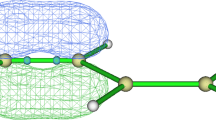Summary
A new transition state algorithm incorporated into the density functional code deMon, has been used to study thetrans →cis-hydroxymethylene andtrans-hydroxymethylene → formaldehyde isomerization processes and to localize the transition state for the decomposition of 1,3-diazacyclobutane to methyleneimine. Calculations have been performed using both local (LSD) and nonlocal spin density (NLSD) gradient-corrected approximations. Two different basis sets of small and large size have been used for the study in order to analyze the effect of the basis set dimension other than that of the nonlocal corrections on the activation energy barrier value. The results seem to confirm that density functional methods can be considered practical and reliable tools for the localization of transition states.
Similar content being viewed by others
References
Fan L, Ziegler T (1990) J Chem Phys 92:3645
Fan L, Ziegler T (1992) J Am Chem Soc 114:10890
Amsterdam Density Functional System (ADF), Department of Theoretical Chemsitry, Vrije Universiteit, Amsterdam, The Netherlands. Baerends EJ, Ros P (1978) Int J Quantum Chem S12: 169
Stanton RV, Merz KM Jr (1994) J Chem Phys 100:434
Abashkin Y, Russo N (1994) J Chem Phys 100:4477
St-Amant A (1992) PhD thesis, Université de Montréal
Abashkin Y, Russo N, Toscano M (1994) Int J Quantum Chem 52:695
McIver JW, Komornicki A (1972) J Am Chem Soc 94:2625
Bell S, Crighton JS (1984) J Chem Phys 80: 2464 and references therein
Banerjee A, Adams N, Simons J, Shepard R (1985) J Phys Chem 89:52
Cummins PL, Gready JE (1989) J Comput Chem 10:939
Halgren TA, Lipscomb WN (1977) Chem Phys Lett 49:225
Rothman MJ, Lohr LL (1980) Chem Phys Lett 70:405
Muller K, Brown LD (1979) Theoret Chim Acta 55:75
Dewar MJS, Healy EF, Stewart JJP (1983) J Chem Soc 87:2745
Cerjan CJ, Miller WH (1981) J Chem Phys 75:2800
Simons J, Jorgensen P, Taylor H, Ozment J (1983) J Phys Chem 87:2745
Jorgensen P, Jensen HJA, Helgaker T (1988) Theoret Chim Acta 73:55
Vosko SH, Wilk L, Nusaiz M (1980) Can. J. Phys. 58:1200
Pezdew JP, Wang Y (1986) Phys Rev B33:8800; Pezdew JP (1986) Phys. Rev. B33:8822
Broyden CC (1970) J Inst Math Appl 6:76
Fletcher R (1970) Comput J 13:317
Goldfarb D (1970) Math Comput 24:23
Shanno DF (1970) Math Comput 24:547
Callomon JH, Hirota E, Kuchitsu K, Lafferty WJ, Maki AG, Pote CS (1976) In: Hellewege KH, Hellewege AM (eds) Structure data on free polyatomic molecules, Landolt-Bornstein, New Series, Group II, vol 7. Springer, Berlin
Hehre WJ, Radom L, Schleyer PvR Pople JA (1986) In:Ab initio molecular orbital theory. Wiley, New York and references therein.
Kamiya K, Morokuma K (1991) J Chem Phys 94:7287
Goddard JD, Yamaguchi Y, Schaefer III, HF (1981) J Chem Phys 75:3459
Deng L, Ziegler T, Fan L (1993) J Chem Phys 99:3823
Becke AD (1988) Phys Rev A38:3098
Pau CF, Hehre WJ (1982) J Phys Chem 86:1252
Saxon RP, Yoshimine M (1989) J Phys Chem 93:3130
Grodzicki M, Seminario JM, Politzer P (1990) Theoret Chim Acta 77:359
Grodzicki M, Seminario JM, Politzer P (1991) J Chem Phys 94:1668
Author information
Authors and Affiliations
Rights and permissions
About this article
Cite this article
Abashkin, Y., Russo, N. & Toscano, M. Transition state localization by a density functional method. Applications to isomerization and symmetry-forbidden reactions. Theoret. Chim. Acta 91, 179–186 (1995). https://doi.org/10.1007/BF01114985
Received:
Revised:
Accepted:
Issue Date:
DOI: https://doi.org/10.1007/BF01114985




